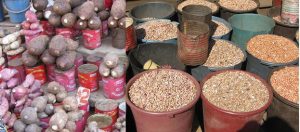How capital determines the structure of agriculture and food systems in Africa
Although finance will not solve all challenges facing developing countries, the structure of African agriculture is largely shaped by the way capital flows into this fundamental sector. In Zimbabwe, for instance, more than 55% of the entire capital devoted to agriculture goes to tobacco with all other commodities competing for the remainder. That situation is not by chance. High tobacco production is directly linked to financing mechanisms. Contractors release money to individual farmers without considering collateral issues because the finance is secured by the crop itself.
The power of structured markets
Tobacco financing mechanisms are also secured by the way the market is structured. Side marketing is minimal because tobacco is linked to a grower’s number. Before the planting season each farmer submits estimated production statistics and expected yields. When the marketing season begins, a farmer who delivers more tobacco than initially estimated will have to convince the Tobacco Industry and Marketing Board (TIMB) that all the tobacco is from his farm. Loan repayment is also guaranteed through an efficient stop order system managed by the TIMB. This is how and why tobacco draws much of the agricultural funding from banks. Viability and profitability to the small scale producer is assured.

What about other commodities?
Other commodities including indigenous foods do not attract much capital because profitability and loan repayment is not assured due the way they are marketed and where they are marketed. Some of the commodities like maize and wheat are government controlled in ways that standardize cost structures as if farmers in different farming areas and rainfall regions incur the same costs. Farmers in Masvingo and Mhangura have different rainfall patterns but they receive the same payment ($726/ metric ton from the Grain Marketing Board (GMB).
Some of the crops like soya bean and sugar bean are contracted by specific private buyers who tend to dictate prices instead of allowing farmers to negotiate prices in correlation with costs of production in different production zones. This compromises viability. In additional, a big proportion of tubers, pulses and grains are sold through open markets where forces of supply and demand determine prices in ways that are not based on costs of production in different areas. If sugar bean, onion, groundnut or tomato supply increases, prices drop drastically. The same happens if there are no takers. All these dynamics do not take into account cost structures.
Other commodities depend on big traders whose take up depend on uncontrolled markets and can stop taking in the event of gluts. Another way in which capital flow is affected by lack of clearly outlined markets is where commodities like sugar bean are mostly bought by commodity brokers who cannot be considered a market since some of them either stop buying when their orders are satisfied or have no permanent presence in the market. Consequently capital flow into commodities that pass through commodity brokers is low as financiers do not have guarantees of repayment.
As a result of all these issues, banks are crowding their financing in tobacco at the expense of other commodities which have more important economic, health and nutritional as well as food security significance. The capital market does not think subsistence crops have a definite market. To fill some of these gaps, there is an increase in financial arrangements involving institutional borrowers like processing companies who are expected to hedge risks as off-takers.
Dangers of concentrating finance in one commodity
Besides limiting opportunities, pouring all funding into one agricultural commodity is at odds with intentions by the financial sector to create and support long-term social, economic and ecological well-being. Unless properly deployed, financial inclusion overlooks economic injustice resulting from all banks financing tobacco as if the whole country is suitable for producing the crop. Environmentally-conscious financing should explore new ways of investing in agriculture and rural development without perpetuating monoculture, resource extraction and inequity. At the moment, very few financial institutions in Africa see a clear link between their financial modelling, climate change and economic justice.
The place of literacy in cultivating a new sense of wealth creation
Low financial literacy levels in most agricultural and rural communities also prevents capital flows into marginal areas and commodities. Agriculture is considered a profession for people who have failed to do sophisticated things in life. Most farmers are not able to prepare a project proposal or complete a loan application form. As a result, banks are consistently funding the same people. This is worsened by a tendency by development financiers and policy makers to insist on rural development and agricultural financing passing through banks.
Besides the fact that banks are located in cities, bankers are not good at identifying opportunities but identifying risks. Most banks will get interested in you when you have already made your money not when you want to use them to create wealth from scratch. Innovation should see more cases where finance goes straight to the grassroots without passing through banks. Meanwhile, what policy makers and development agencies may think is a financial problem could be about a primitive sense of wealth creation. That is why soft assets like knowledge and skills are increasingly being considered part of development support.
charles@knowledgetransafrica.com / charles@emkambo.co.zw / info@knowledgetransafrica.com
Website: www.emkambo.co.zw / www.knowledgetransafrica.com
Mobile: 0772 137 717/ 0774 430 309/ 0712 737 430
